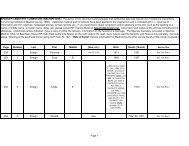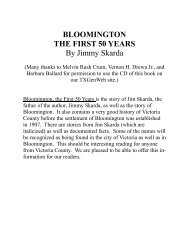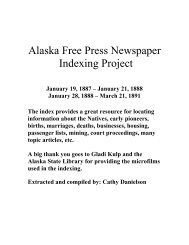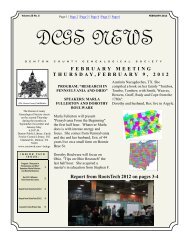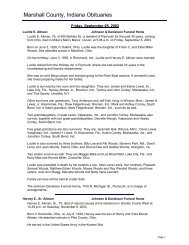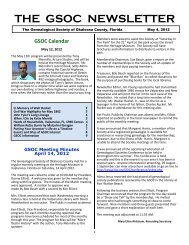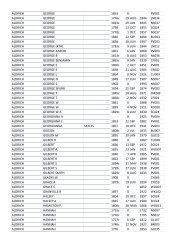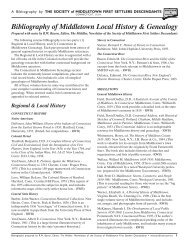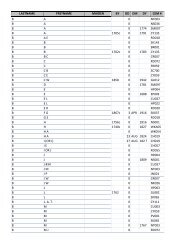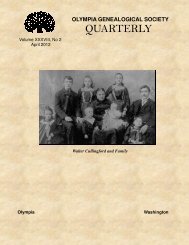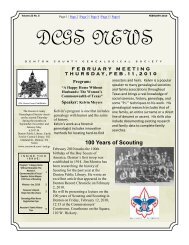Indian population in the United States and Alaska. 1910 - RootsWeb
Indian population in the United States and Alaska. 1910 - RootsWeb
Indian population in the United States and Alaska. 1910 - RootsWeb
You also want an ePaper? Increase the reach of your titles
YUMPU automatically turns print PDFs into web optimized ePapers that Google loves.
STOCKS AND TRIBES, BY SEX, AGE, AND BLOOD. 83<br />
tion to <strong>the</strong>se areas <strong>in</strong> <strong>the</strong> <strong>United</strong> <strong>States</strong>, tribes of this<br />
stock occupied most of <strong>the</strong> pen<strong>in</strong>sula region of Ontario<br />
<strong>and</strong> <strong>the</strong> shores of <strong>the</strong> St. Lawrence as far down as<br />
Queibec or below.<br />
The <strong>Indian</strong>s of <strong>the</strong> Iroquoian stock <strong>in</strong> <strong>the</strong> <strong>United</strong><br />
<strong>States</strong>, as enumerated <strong>in</strong> <strong>1910</strong>, numbered 39,679. To<br />
this figure should be added probably about 1,500 to<br />
2,000 for <strong>Indian</strong>s of this stock reported without dist<strong>in</strong>ction<br />
of tribe, among <strong>the</strong> general <strong>population</strong> <strong>in</strong> New<br />
York, North CaroHna, Tennessee, South Carol<strong>in</strong>a, <strong>and</strong><br />
Oklahoma, mak<strong>in</strong>g a probable total of over 41,000 <strong>in</strong><br />
all. The tribes of this stock, for which members<br />
were reported, are as follows<br />
Cayuga. Oneida. Seneca.<br />
Cherokee. Onondaga. Tuecarora.<br />
Mohawk. St. Regis. Wy<strong>and</strong>ot.<br />
Cayuga.—One of <strong>the</strong> five tribes of <strong>the</strong> Well-known<br />
Iroquois Confederacy. Their habitat, when first<br />
known to Europeans <strong>in</strong> <strong>the</strong> seventeenth century, was<br />
<strong>in</strong> <strong>the</strong> vic<strong>in</strong>ity of Cayuga Lake, N. Y. At <strong>the</strong> close of<br />
<strong>the</strong> eighteenth century <strong>the</strong> majority emigrated to<br />
Canada, where <strong>the</strong>y are now liv<strong>in</strong>g on a reservation <strong>in</strong><br />
Ontario. Of <strong>the</strong> rema<strong>in</strong>der, part moved to Oklahoma<br />
<strong>and</strong> part to Wiscons<strong>in</strong>, where <strong>the</strong>y are liv<strong>in</strong>g with <strong>the</strong><br />
Oneida, but were not returned as Cayuga <strong>in</strong> <strong>the</strong> present<br />
census. Those rema<strong>in</strong><strong>in</strong>g <strong>in</strong> New York are located<br />
ma<strong>in</strong>ly on <strong>the</strong> Cattaraugus <strong>and</strong> Tonaw<strong>and</strong>a Reserva-<br />
tions.<br />
The number enumerated <strong>in</strong> <strong>1910</strong> was 81, of which 53<br />
were <strong>in</strong> New York <strong>and</strong> 17 <strong>in</strong> Oklahoma. The Commis-<br />
sioner of <strong>Indian</strong> Affairs reported 182 for this tribe <strong>in</strong><br />
New York <strong>in</strong> <strong>1910</strong>, <strong>and</strong> a practically stationary popular-<br />
tion for <strong>the</strong> past 35 years. The great difference between<br />
this figure <strong>and</strong> <strong>the</strong> census report is due probably<br />
to <strong>the</strong> enumeration by <strong>the</strong> census of many <strong>Indian</strong>s<br />
without dist<strong>in</strong>ction of tribe among <strong>the</strong> general popula-<br />
tion. The figures for this tribe <strong>in</strong> New York s<strong>in</strong>ce<br />
1875, as given <strong>in</strong> <strong>the</strong> <strong>Indian</strong> reports, are as follows:<br />
YEAB.<br />
:



